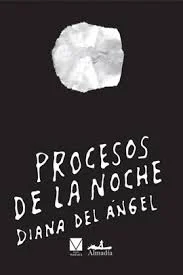On Diana del Ángel’s Procesos de la Noche
By Isaías Rogel
“The body of Julio César Mondragón was abandoned on the road to Iguala and his torturers wanted their message to be heard; this much was clear from the moment someone took the picture that went viral on social media.” The first sentence of the prologue of Diana del Ángel’s Procesos de la noche sets the tone. Mondragón—a victim of the Ayotzinapa mass student kidnapping and disappearance—was found with his eyes gouged out and face skinned off on the 27th of September 2014. The perpetrators were police officers who turned the students over to the local crime syndicate.
On the surface, Diana del Ángel’s Procesos de la noche is the story of a family in the pursuit of truth. Del Ángel’s book is a crónica, a genre specific to Latin America wherein real world events are examined in a way that’s similar to what English-language readers know as “creative nonfiction.” In the book, she accompanies widowed Marisa and her lawyer Sayuri through a lengthy and persistent journey in their pursuit of justice. Whether tracing the literary history of the Spanish word desollar—to skin—or the judicial procedures that coincide with requesting a second autopsy, Del Ángel’s attention to use of language and narrative structure play an important role in reconstructing both Julio’s face and a difficult political reality.
Although the book itself can easily sit between nonfiction and investigative journalism, Del Ángel’s meticulous use of movement on the page challenges being easily categorized and mirrors an essayist. Procesos de la noche opens with a lesson on colonial violence and linguistics. She traces the word desollado from the conquest of “New Spain” to Julio César Mondragón. Del Ángel’s decision to introduce the case with a preface on language—and the violence bound to it—works as a theoretical framework, signaling to the reader to pay attention.
The book comprises dense chapters detailing Marisa and Sayuri’s progress with the case, interwoven with personal testimonies from friends and family. As the book progresses, Del Ángel explores how people see Julio and his case. There is the dry, sterile judicial perspective—legal paperwork and autopsy results that reduce Julio to skin and bone. Then the much more personal—family and friends recounting Julio’s capacity to love and foster the best in people. The two perspectives elicit a strong emotional response by positioning the reader as both a witness and a friend—as the judicial erases humanity the personal negates this and invokes empathy. This dichotomy elucidates the authority of language over perception. There’s a clear difference in language between the two narrative arcs. The strength in Del Ángel’s style manifests in how she teaches the reader to identify the inner workings of language through juxtaposition.
As the reader further engages with Del Ángel, we begin to tease out what could be her central thesis—“La primera barrera entre la justicia y las personas es el lenguaje,” the first barrier between people and justice is language. The basis of her argument develops in the opening pages. Del Ángel delineates the history of desollar by utilizing Spanish colonial perspectives. Authority is assigned to language by privileging their voices. In retaliation, Del Ángel interrupts these accounts with the use of según—according to—as if to create a distance between her perspective and others. Similarly, Del Ángel titles all the personal accounts Rostro—face. The visual repetition of rostro and the voices of family and friends work to weaken the authority of judicial language upon Julio’s body. Whether approaching this book as an expert or with little-to-no-knowledge of the Ayotzinapa case in Mexico—Del Ángel’s work is fundamental in understanding not only Julio’s case, but the narrative of government violence enacted on the people of any nation state.
Isaiás Rogel is an undergraduate at NEIU where he studies English and Latin American Studies. As a longtime resident of the West Humboldt Park neighborhood, his writing explores the meeting of different cultures and shifting identities in segregated spaces. As the prose editor at Seeds—NEIU’s literary journal—his mission is to help students of color express their personal narratives through writing.
A poet, essayist and human rights defender, Diana del Ángel was a fellow of the Foundation for Mexican Letters and FONCA. She held a literary residency at Fondo Ventura/Almadía. She is the author of Barranca (2018) and Procesos de la noche (2018), and her translations from Nahuatl to Spanish appear in Fundación magazine. Her work has appeared in the anthologies 9 poets who fear clowns (2016), Encuentro Nacional de Poetas Jóvenes. Ciudad de Morelia (2016) and Fuego de dos fraguas (2016).


